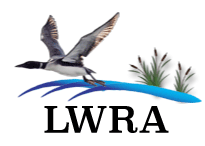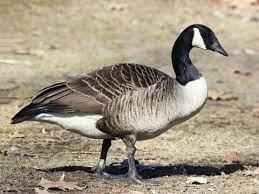Canada Geese and our Lakes
After a long and very cold winter, the ice and snow are finally leaving our lakes. And on schedule, migrant birds are returning, including Canada Geese. Now is the time to think about measures we can take to make our lakes a little less hospitable for them.
Geese eat plant material on land, but are frequently out on the water when they defecate. This material is high in nutrients. These nutrients are the same ones used for growth by algae and plants in the lake, and nutrient loading can contribute to algal blooms and excessive plant growth. In fact, one Canada goose can contribute about a half pound of phosphorus to the lake each year!
Migrating Canada Geese tend to return to the same spots year after year. The lack of predators and abundance of food allows Canada geese to lay more eggs and have more goslings survive to adulthood, so a small population can quickly grow into a large population.
There are measures we can take to discourage Canada Geese from making our lakes their home.
1. Don’t feed the geese! Bread products are not very nutritious for geese, and any handouts habituate them to being fed and make them dependent.
2.Scare tactics. Allowing your dog to chase them may discourage them from sticking around.
A fluttering flag constructed from a black plastic garbage bag and mounted on a tall pole has also been found to discourage geese. Geese do not like to feed in areas where they sense a threat from overhead, which the fluttering flag represents to them. The dimensions of the flag should be about 0.6 metre by 1 metre. Two or three slits about one-third the length of the flag should be cut in the end of the flag, to make three or four flaps. The flag should be mounted at least 2.5 metres above the ground.
Geese may be disturbed by water sprays designed to activate when movement is detected by infrared sensors. The advantage of these devices is that they can operate unattended 24 hours a day , but their effectiveness is limited to quite small areas.
Decoys such as plastic owls and snakes can be used, but are not likely to be effective.
3. Using barriers is a short term fix. A common design for a goose fence has two strands of nylon cord, heavy monofilament fishing twine, or even ordinary string strung between short posts. The first strand is placed about 6 inches above the ground, while the second is placed at about 12 inches. These barriers are not impossible for geese to cross, but it is inconvenient–and Canada geese dislike being inconvenienced. This type of barrier works best when strung at the water's edge or around an area that you want to exclude geese. To be effective, the geese should not be able to walk around the fence.
4. Modify your shoreline. Canada geese don't like to nest in, or walk through tall grasses, plants, or shrubs. Leaving a buffer zone of natural plants around the lakes will discourage geese from nesting on our lakes. Any small beach openings can be fenced off using the barriers described above. Minimizing the amount of your property dedicated to lawn will give them fewer places to nest and eat. As a bonus, you will need to do less mowing, leaving more time for relaxing on the dock!

